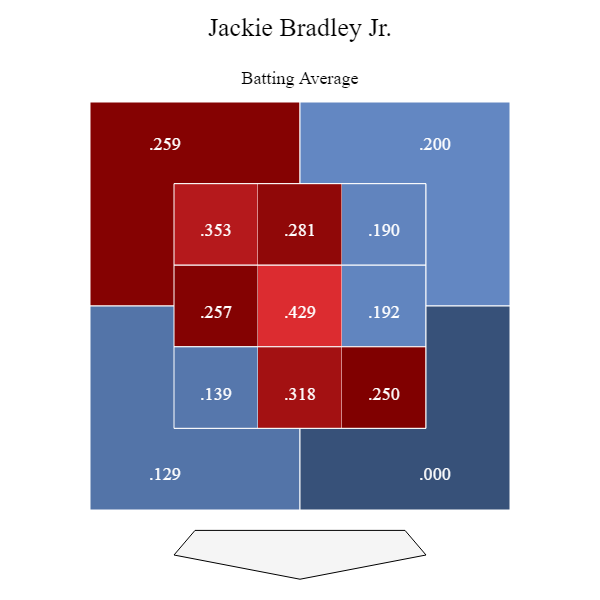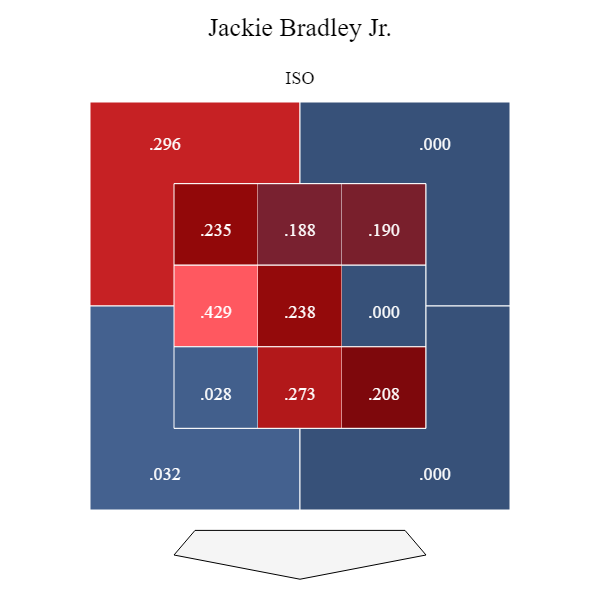(Photo by Frank Jansky/Icon Sportswire)
Last night, Boston Red Sox outfielder Jackie Bradley Jr./strong>. thumbed his nose at the numbers and made Houston Astros closer Roberto Osuna the goat (not THAT G.O.A.T) en route to an 8-2 victory for the Sox. Osuna did everything right during this at-bat. He was aware of Bradley, Jr.’s weaknesses and attempted to expose them in a high-leverage situation. It didn’t work out when theortically it should have. I’ll take a look at the at-bat from both Osuna’s point of view as well as JBJ’s.
Now, Osuna did this to himself. He had the Sox down to two outs before giving up a single to Rafael Devers, then hitting both Brock Holt and Mitch Moreland to load the bases. Up comes JBJ, who has been causing a fair amount of damage this series. Osuna had a good game plan to get him out.
Or so he thought.
Through the 2018 season, JBJ has not hit pitches up and/or in the zone. Take a look at his batting average against right-handed pitching.

CHART 1
Osuna recognized that he’ll have to keep the ball either up and in or down and away to be most effective against JBJ. Then consider JBJ’s ISO against righties in 2018.

CHART 2
OK, so he could do a little damage when he makes contact up and in, but considering the entire area (up and/or in), it’s not a location that would produce much power (~ .080 ISO). Furthermore, have a look at his average exit velocity in those locations.

CHART 3
Again, when considering the zones in which Osuna attacked JBJ, he was doing the right thing. Or, at least that’s what the numbers would tell us.
Let’s review the three pitches and their locations during the plate appearance.
[gfycat data_id=”FairThoseCockatiel”]
Osuna delivered a 97 MPH four-seam fastball middle inside; that location averages a .100 BA, .000 ISO, and a 66 MPH average exit velocity for JBJ. In terms of Perry Husband’s Effective Velocity, if JBJ wanted to time that pitch perfectly, he’d have to be ready for a pitch at about 100 (EV)MPH.
Pitch number two, way inside and down, was simply a waste pitch. No need to view the pitch or dig into any data, but this will have some relevance later.
So here we are, even count, two outs and the bases loaded. It should be noted that, much like a lot of hitters in Major League Baseball, JBJ loves the fastball. In this count specifically, the sample size is much too small to glean any sort of tendency. But, for the record, the next pitch (the HR pitch) location sees JBJ hitting .333 (1 for 3).
Osuna decides to change eye levels, pump up the velocity and go up and in; the ideal location against JBJ if you go back and look at the three zone charts. But then, something goes horribly wrong.
[gfycat data_id=”FlakyNaiveBlobfish”]
JBJ manages to get his barrel around on time while pulling his hands in to cheat on his timing and drives the ball out for a grand slam home run. EV data says the pitch, to be hit as well as JBJ did, would have to be timed at 100 (EV)MPH. Yes, another pitch at 100 EvMPH (if you’ve been following my recent articles, you’ll know where I’m going to go with this in a moment).
And with that, game over; series momentum shifts directly to the Red Sox.
Let’s now jump to JBJ’s point of view (or what we can surmise he did to prepare). Osuna’s 2018 was about half a season’s worth of data, so I’m going to include 2017 numbers as well when reviewing his tendencies.

CHART 4
Pretty easy to figure out you’re getting a steady diet of fastballs from Osuna, especially if you’re a left-handed hitter. Osuna was ahead after the first pitch and (somewhat predictably?) threw JBJ a slider, yet it landed nowhere near the zone. Next, we can see by looking down at Chart 5 that Osuna has been attacking lefties down and out of the zone. He’s shown that he will go middle/middle away, but much less so. Take a look at the HR zone as well; 2.43% of pitches are thrown there to lefties.

CHART 5
Lastly, JBJ was probably aware that Osuna averages about 96 MPH on his fastball. Let’s just assume that he’s keeping his attention around the mid-90s to maybe the high 80’s. That would make sense as you can see from the screenshot below because JBJ knew he’d have to cheat to make contact with this pitch. Unfortunately for Osuna, he made good contact high in the zone which facilitated a sufficient launch angle in conjunction with JBJ’s exit velocity; and you have big home run.

In retrospect, one thing Osuna should have been aware of is that JBJ whiffs on sliders more than any other pitch you throw at him. Pitch two should have been located much closer to the zone because JBJ has a tendency to whiff a lot at low and inside as well. If that ended up being the case, perhaps we are looking at a much different game (perhaps). In addition to that, Osuna could have taken advantage of EV by putting the slider low and inside, then following it up with the four-seam fastball in the same general location (where the HR was hit). What’s more is that Osuna might have done well to tunnel the four-seam with that previously-thrown slider for a much better result along with that large (effective) velocity spread. Instead, we have a situation where JBJ was more equipped to handle the up and in velocity, because Osuna already threw him a fastball at the same exact EV, albeit a bit lower in the zone. Of course, it could be a simple as JBJ taking a chance and guessing (he did have two more strikes to work with) while Osuna did nothing more than throw the ball into his bat. But remember, this is all under the umbrella of theoretics.
The ingredients were there for a successful at-bat for Osuna; overall he did right according to the numbers. The data told Osuna that JBJ shouldn’t have been able to hit the pitch (if he was to make contact) hard at all. With it being up and inside, more often than not we have a ground ball situation that ended the inning with anyone’s guess as to the final score.
A quote from New York Yankees radio announcer John Sterling is appropriate here; “You can’t predict baseball, Suzyn!”

a fantastic read Bitniex